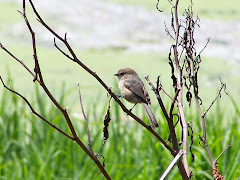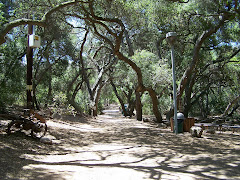 Male House Sparrow in breeding plumage--not always this bright.In non-breeding plumage the brown is duller and the bill is lighter. Less black in the bib. This aggressive invader was purposely introduced in the 1800s. (OC Birder Girl Picture)
Male House Sparrow in breeding plumage--not always this bright.In non-breeding plumage the brown is duller and the bill is lighter. Less black in the bib. This aggressive invader was purposely introduced in the 1800s. (OC Birder Girl Picture)
I received a question about a bird identification.
Question:
"Hello, I live in South Orange County (Laguna Niguel). I am now taking up the hobby of feeding birds.There are a couple of birds I'd like to know what they are."
 Female House Sparrow--No streaking on chest.
Female House Sparrow--No streaking on chest. (OC Birder Girl Picture)
"1. One bird is a little bit larger than a House Finch, is a dull brown color, and likes to forage on the ground. When he is at the feeder, I notice he scratches some of the seed off so it goes to the ground. He seems to be on the aggressive side. When I opened the door to go outside, he was nearby, jumped on a fence but didn't fly away."
 Black Phoebe--Sayornis nigricans is a native species.
Black Phoebe--Sayornis nigricans is a native species. (OC Birder Girl picture)
"2. The other bird is a cute little black and gray one. He's black on top, and seems to be gray on the underside. Flat on the head. He makes a cute little peep and flits from here to there.If you can ID these birds for me I'd appreciate it. I just taken up bird feeding and am curious on what species they are. "
Answer:
Hmmmm. Well, hard to tell without a picture, and I could be wrong, but I would say that bird #1 might be a House Sparrow (not finch), and bird #2 might be a
Black Phoebe, but a
Black Phoebe is white below. If I saw a picture, I could tell you for sure. If you have one up on Flicker, you can send me the link and I will look at it and tell you.
The slightly larger House Sparrows are very aggressive and depending on the season may be dull brown, and the females are very like most sparrows and finches. Drab brown but unlike most sparrows the House Sparrow female is not streaked. The House Sparrow aka English Sparrow is an alien species that nests in cavities in trees and in houses and in street signs that are double. In other words, wherever they can. I often used to see their nesting material hanging out of street signs in the San Fernando Valley. House Sparrows endanger other birds like Western Blue Birds and Swallows who also nest in cavities. They compete for nesting cavities, and they kill others species they think might be competition or just happen to be near by. They are often called "The McDonald's Bird" because they are often seen at McDonald's and other fast food or outdoor restaurants begging for food. They can be quite tame and often aren't afraid of humans. FYI if you love native birds, don't feed these aggressive birds. They like a lot of the cheaper seeds like millet. See the section on
Feeding in the Silias site below.
The
Black Phoebe is a flycatcher. It flies out and back catching flying bugs. It makes a "cheep" call sound. It is a cute little bird and there are more in Orange County than any other county in the United States. They can easily be seen in Huntington Central Park and other parks in the area, but are also found in local yards. Every home seems to have one.
Good Luck with feeding the birds, and thank you for your question.
Home -
Index -
Contact -
Shop -
Ask the OC Birder Girl -
OC Birder Girl Videos


 Concentration.
Concentration.
 These two staked out the post--obviously they have been there for a while. They defended it against any tern that ventured near.
These two staked out the post--obviously they have been there for a while. They defended it against any tern that ventured near. Nesting Colony of terns.
Nesting Colony of terns.





 Male House Sparrow in breeding plumage--not always this bright.In non-breeding plumage the brown is duller and the bill is lighter. Less black in the bib. This aggressive invader was purposely introduced in the 1800s. (OC Birder Girl Picture)
Male House Sparrow in breeding plumage--not always this bright.In non-breeding plumage the brown is duller and the bill is lighter. Less black in the bib. This aggressive invader was purposely introduced in the 1800s. (OC Birder Girl Picture)  Female House Sparrow--No streaking on chest. (OC Birder Girl Picture)
Female House Sparrow--No streaking on chest. (OC Birder Girl Picture)





